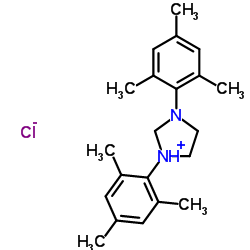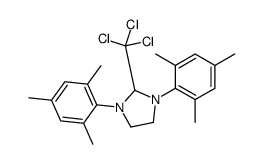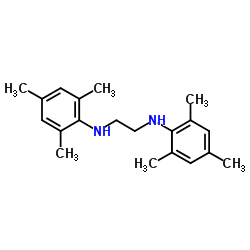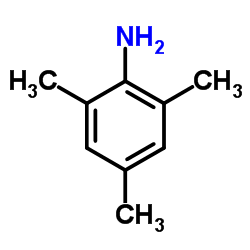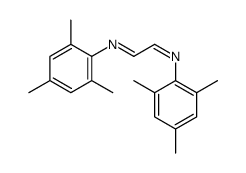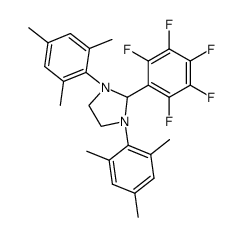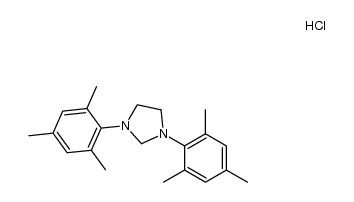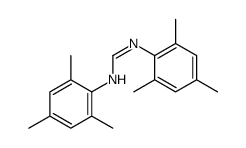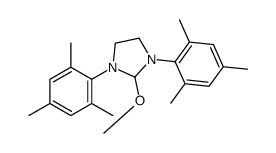173035-11-5
| Name | 1,3-bis(2,4,6-trimethylphenyl)-4,5-dihydro-2H-imidazol-1-ium-2-ide |
|---|---|
| Synonyms |
C-2353
1,3-bis-(2,4,6-trimethylphenyl)-imidazolin-2-ylidene 1,3-bis(2,4,6-trimethylphenyl)-4,5-dihydroimidazol-2-ylidene D3897 1,3-bis(2,4,6-trimethylphenyl)imidazolidin-2-ylidene 1,3-bis(2,4,6-trimethylphenyl)-4,5-dihydroimidazolin-2-ylidene N,N'-bis(2,4,6-trimethylphenyl)-4,5-dihydroimidazol-2-ylidene SIMes 1,3-Bis(2,4,6-trimethylphenyl)-2-imidazolidinylidene |
| Melting Point | 85-100 °C |
|---|---|
| Molecular Formula | C21H26N2 |
| Molecular Weight | 306.44500 |
| Exact Mass | 306.21000 |
| PSA | 6.48000 |
| LogP | 4.70350 |
| Storage condition | 2-8°C |
|
Section 1: Product Identification Chemical Name:1,3-Bis(2,4,6-trimethylphenyl)-4,5-dihydroimidazol-2-ylidene, min. 98% CAS Registry Number:173035-11-5 Formula:C21H26N2 EINECS Number:none Chemical Family:N-heterocyclic carbene Synonym:none
Section 2: Composition and Information on Ingredients IngredientCAS NumberPercentACGIH (TWA)OSHA (PEL) Title compound173035-11-5100%no datano data Section 3: Hazards Identification Emergency Overview:Irritating to skin, eyes and respiratory tract. Primary Routes of Exposure:Inhalation, skin, eyes Eye Contact:Causes slight to mild irritation of the eyes. Skin Contact:Causes irritation to the skin Inhalation:Irritating to the nose, mucous membranes and respiratory tract. Ingestion:No information available on the physiological effects of ingestion. May be harmful if swallowed. Acute Health Affects:Irritating to skin, eyes and respiratory tract. Chronic Health Affects:No information on long-term chronic effects. NTP:No IARC:No OSHA:No SECTION 4: First Aid Measures Immediately flush the eyes with copious amounts of water for at least 10-15 minutes. A victim may need Eye Exposure: assistance in keeping their eye lids open. Get immediate medical attention. Wash the affected area with water. Remove contaminated clothes if necessary. Seek medical assistance if Skin Exposure: irritation persists. Remove the victim to fresh air. Closely monitor the victim for signs of respiratory problems, such as difficulty Inhalation: in breathing, coughing, wheezing, or pain. In such cases seek immediate medical assistance. Seek medical attention immediately. Keep the victim calm. Give the victim water (only if conscious). Induce Ingestion: vomiting only if directed by medical personnel. SECTION 5: Fire Fighting Measures Flash Point:no data Autoignition Temperature:no data Explosion Limits:no data Extinguishing Medium:carbon dioxide, dry powder or foam If this product is involved in a fire, fire fighters should be equipped with a NIOSH approved positive pressure Special Fire Fighting Procedures: self-contained breathing apparatus and full protective clothing. Hazardous Combustion andIf involved in a fire this material may emit irritating fumes. Decomposion Products: Unusual Fire or Explosion Hazards: Flammable solid. SECTION 6: Accidental Release Measures Eliminate all ignition sources. Small spills can be mixed with vermiculite, sodium carbonate or other suitable Spill and Leak Procedures: non-combustible adsorbent and swept up. SECTION 7: Handling and Storage Handling and Storage:Store in a tightly sealed container under an inert atmosphere of nitrogen or argon. Keep in a cool, dry place. SECTION 8: Exposure Controls and Personal Protection Eye Protection:Always wear approved safety glasses when handling a chemical substance in the laboratory. Skin Protection:Wear protective clothing and gloves. Ventilation:Handle the material in an efficient fume hood. If ventilation is not available a respirator should be worn. The use of respirators requires a Respirator Respirator: Protection Program to be in compliance with 29 CFR 1910.134. Ventilation:Handle the material in an efficient fume hood. Additional Protection:No additional protection required. SECTION 9: Physical and Chemical Properties Color and Form:white to off-white powder Molecular Weight:306.45 Melting Point:no data Boiling Point:no data Vapor Pressure:no data Specific Gravity:no data Odor:none Solubility in Water:insoluble SECTION 10: Stability and Reactivity Stability:air sensitive, moisture sensitive Hazardous Polymerization:no hazardous polymerization Conditions to Avoid:exposure to air and moisture Incompatibility:oxidizing agents Decomposition Products:carbon monoxide, carbon dioxide, nitrogen oxides and organic fumes SECTION 11: Toxicological Information RTECS Data:No information available in the RTECS files. Carcinogenic Effects:no data Mutagenic Effects:no data Tetratogenic Effects:no data SECTION 12: Ecological Information Ecological Information:No information available SECTION 13: Disposal Considerations Disposal:Dispose of according to local, state and federal regulations. SECTION 14: Transportation Shipping Name (CFR):Flammable solids, Organic, N.O.S. Hazard Class (CFR):4.1 Additional Hazard Class (CFR):NA Packaging Group (CFR):II UN ID Number (CFR):UN# 1325 Shipping Name (IATA):Flammable solid, Organic, N.O.S. Hazard Class (IATA):4.1 Additional Hazard Class (IATA):NA Packaging Group (IATA):II UN ID Number (IATA):UN# 1325 SECTION 15: Regulatory Information TSCA:Not listed in the TSCA inventory SARA (Title 313):Title compound not listed Second Ingredient:none SECTION 16 - ADDITIONAL INFORMATION N/A |
| RIDADR | NONH for all modes of transport |
|---|
| Precursor 9 | |
|---|---|
| DownStream 2 | |

